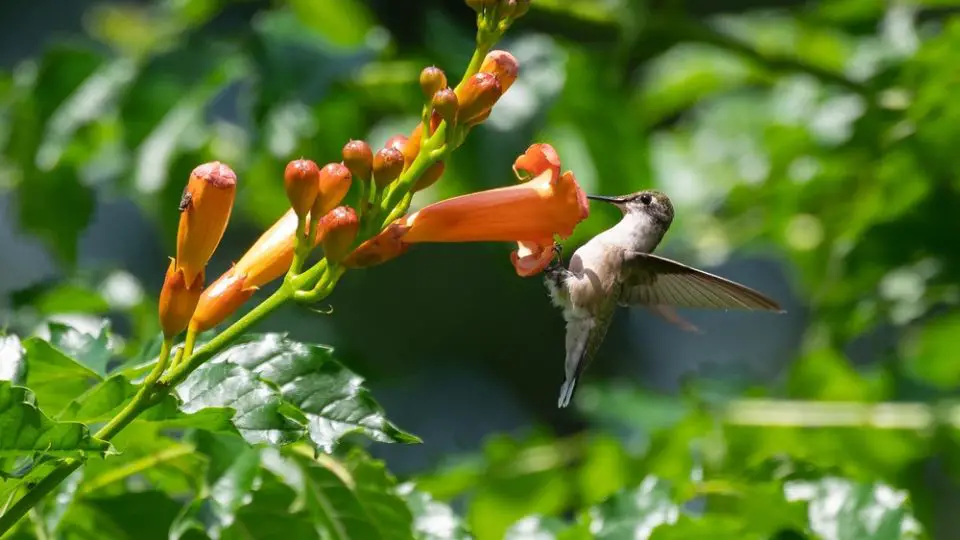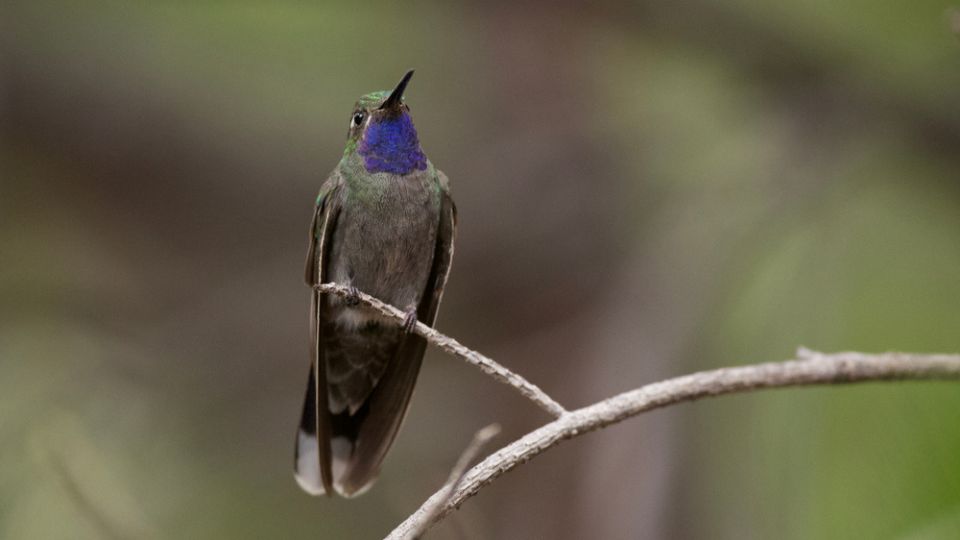Colorado is home to various different species of hummingbirds. They arrive by mid-April and leave Colorado by mid-September. Migratory hummingbirds pass through the state twice a year on their way to spring breeding grounds or wintering grounds. Occasionally Colorado reports sightings of vagrant hummingbirds who usually stay further south.
Most hummingbirds leave Colorado in September. Some species may stay until October or November, but most hummingbirds migrate south in early fall.
Hummingbirds are drawn to Colorado for the Rocky Mountains, as well as high elevation forests, rivers, and low scrubs. Hummingbirds come to feed on local flowers and enjoy nectar from backyard feeders.
Read on to discover which species of hummingbirds migrate to Colorado. Learn the basics of attracting Colorado hummingbirds and how hummingbirds survive snowstorms and cold nights.
Table of Contents
When Do Hummingbirds Return To Colorado?
Hummingbirds, like many other wild birds, fly south for the winter. Migrating hummingbirds begin to return to Colorado by mid-April.
Some set up residence in the state, while others migrate through on their way to the northern US or Canada. One hummingbird species, the Black-chinned Hummingbird, is commonly spotted in Colorado during the breeding season.
When Should I Put Up Hummingbird Feeders In Colorado?
Colorado residents should put feeders up no later than the last week of March. At first, it may appear as though hummingbirds haven’t arrived yet, as they are harder to spot at the beginning of the season.
Hummingbirds remember where their food sources are, however, and will return to feeders year after year. Keep these birds supplied with fresh sugar water even if you don’t see them!
When Do Hummingbirds Leave Colorado?
Hummingbirds leave Colorado between early September and mid-October. Migrants pass through Colorado on their way to wintering grounds further south.
Some hummingbirds may stay through November, but most will leave earlier on their way to wintering grounds in the southern US or Mexico. Leave hummingbird feeders out about two weeks after you see the last hummingbird.

Where Do Colorado Hummingbirds Go In Winter?
Most hummingbirds winter in South or Central America. Hummingbirds’ migratory behavior is the result of their natural circadian rhythms.
Even though the seasons arrive differently each year, hummingbirds can react to the changes in their environment. They may adjust their migration dates depending on when flowers bloom or snow melts.
Subtle environmental changes signal that it’s time for them to prepare for migration. Hummingbirds feed constantly and put on a layer of fat before fall and spring migration.
Many species of hummingbirds migrate thousands of miles across North America. The Ruby-throated flies 500 miles straight across the Gulf of Mexico during both the spring and fall migration.
Do Hummingbirds Live in Colorado In The Winter?
Generally, no, Colorado hummingbirds don’t stay for the winter. Some hummingbirds may be too old to migrate and may end up staying for the winter.
Most hummingbirds, though, fly south during fall migration. They need numerous flowering plants to provide food at all times.
What Happens To Hummingbirds In Colorado When There Is A Snowstorm?
Hummingbirds have the ability to enter torpor in cold weather. They slow their metabolism, heart rate, and breathing. Hummingbirds conserve energy when they are in torpor.
This allows hummingbirds to sustain their bodies in a snowstorm. Afterward, they need to feed immediately in order to stay alive.
How Should I Prepare For Hummingbirds In Colorado?
The best way to prepare for hummingbirds is to create a habitat for them. Make your own hummingbird nectar from 4 parts water to 1 part table sugar.
Hang hummingbird feeders away from other wild bird feeders, ensuring the hummingbirds have a safe place to feed. Once you’ve established a feeder, hummingbirds will return to it year after year.
Plant native plants to attract hummingbirds. These tiny birds are drawn to bright colored flowers in tubular shapes. Colorado native plants include
- Golden spur columbine
- Giant hyssop
- Bee balm
- Trumpet vines
- Lupines
Depending on the elevation of your space, different native plants will thrive and provide food sources for hummingbirds.

Species of Hummingbirds Commonly Seen in Colorado Throughout The Season
Three species of hummingbirds are seen in Colorado throughout the season. The Black-chinned hummingbird, the Broad-tailed Hummingbird, and the Rufous Hummingbird. There have in fact been fewer reported sightings of the Calliope Hummingbird, but some still consider it a summer resident.
Broad-tailed Hummingbird
- Most common hummingbird in the state
- Arrive by late April for breeding grounds
- Found in the western part of this state, prefer higher elevations
- Frequent use of torpor because they live in high elevations
- Males identified by an iridescent rose throat (gorget)
Black-chinned Hummingbird
- The main hummingbird that breeds in Colorado
- Arrive mid-May or June
- Frequents both deserts and mountain forests through Colorado, Nevada, Montana, and Idaho
- Males have black gorgets with a purple spot underneath
- Females have pale throats and white tips on their tail feathers
Calliope Hummingbird
- Less common but still considered a resident
- Sightings mainly in July or August
- Migrates for breeding grounds between the Pacific Coast, Rocky Mountains,
- Large groups found in Wyoming and parts of Canada
- Males known for bright magenta gorget
- Smallest bird in the US
Rufous Hummingbird
- Generally spotted in late summer, leaving Colorado by late August
- Migrate down the Pacific Coast and the Rocky Mountains in the fall
- Fly 4,000 miles for migration between Alaska and Mexico
- Known for their bright orange color
- Males have an iridescent red gorget
- Allen’s Hummingbirds look very similar but are rare in Colorado

Species of Hummingbirds Rarely Seen In Colorado Throughout The Season
Six species of hummingbirds are accidental visitors to Colorado. Several have been spotted only once or twice in the state. These include Anna’s, Blue-throated Mountain Gem, Costa’s, Rivoli’s, Ruby-throated, and the White-eared Hummingbird.
Anna’s Hummingbird
- Live in southwestern Utah year-round, but some fly to Colorado
- The only hummingbird species that doesn’t migrate
- Anna’s stay between Baja California and the western US
- Males have pinkish gorgets, and their bodies are green and gray
Blue-throated Mountain Gem
- Very rare, the only sighting was in Bellvue
- Largest hummingbird that nests in the US
- Blue-throated live in the extreme southern US and Mexico
- Males have iridescent blue throats
Costa’s Hummingbird
- Residents of Baja California, southern California, and Arizona
- Iridescent purple gorget and crown
Rivoli’s Hummingbird
- Seen mostly around Denver and Fort Collins
- Larger species of hummingbird
- Live in Mexico and Central America
- Migrate to Arizona, Texas, and New Mexico
- Males have purple crowns and green gorgets
Ruby-throated Hummingbird
- Sightings in Denver and Colorado Springs around September
- Range in the eastern 2/3 of the US
- Some winter in Texas, while others cross the Gulf of Mexico for wintering grounds
- Males known for ruby-red gorget and iridescent green body
White-eared Hummingbird
- The last sighting was in 2005
- Range between extreme southern US down to Nicaragua
- Both males and females are green on their backs and breasts
- Males and females have white stripes above their eye

